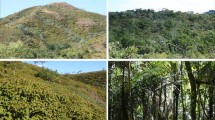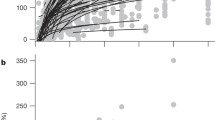Abstract
Restoring species-rich tropical forests is an important activity because it helps mitigate land deforestation and degradation. However, scientific understanding of the ecological processes responsible for forest restoration is poor. We review the literature to synthesize the current state of understanding of tropical forest restoration from a biogeochemical point of view. Aboveground biomass and soil carbon accumulation of restored tropical forests are a function of age, climate, and past land use. Restored forests in wet life zones accumulate more biomass than those in moist or dry life zones. Forests restored on degraded sites accumulate less aboveground biomass than forests restored on pastures or agricultural land. Rates of aboveground biomass accumulation in restored forests are lower than during natural succession, particularly during the first decades of forest establishment. Rates of litterfall, biomass production, soil carbon accumulation, and nutrient accumulation peak during the first few decades of restored forest establishment and decline in mature stages. Changes in species composition and canopy closure influence the rate of primary productivity of older restored stands. Species composition also influences the rate and concentration of nutrient return to the forest floor. The ratio of primary productivity to biomass is high in young restored forests and low in mature stands irrespective of climate. The ratio is low when past land use has little effect on biomass accumulation, and high when past land uses depresses biomass accumulation. This effect is due to a high rate of litterfall in restored forests, which helps restore soil by circulating more nutrients and biomass per unit biomass accumulated in the stand. The degree of site degradation and propagule availability dictates the establishment and growth of tree species. Reestablishment of forest conditions and the enrichment of sites by plant and animal species invasions lead to faster rates of succession, aboveground primary productivity, and biomass accumulation in restored forests. Our review demonstrates that nutrient cycling pathways and nutrient use efficiency are critical for interpreting the suitability of tree species to different conditions in forest stands undergoing restoration.
Similar content being viewed by others
References
Aide, T. M., Zimmerman, J. K., Herrera, L., Rosario, M. and Serrano, M.: 1995, ‘Forest recovery in abandoned tropical pastures in Puerto Rico’, For. Ecol. Manage. 77, 77-86.
Ashton, M. S., Gunatilleke, C. V. S., Singhakumara, B. M. P. and Gunatilleke, I. A. U. N.: 2001, ‘Restoration pathways for rain forest in southwest Sri Lanka: A review of concepts and models’, For. Ecol. Manage. 154, 409-430.
Attiwill, P. M. and Leeper, G. W.: 1987, Forest Soils and Nutrient Cycles, Melbourne University Press, Australia, pp. 202.
Bernhard-Reversat, F. and Loumeto, J. J.: 2002, ‘The litter system in African forest-tree plantations’, in V. M. Reddy (ed.), Management of Tropical Plantation-forests and Their Soil-litter System, Science Publishers Inc., Enfield, New Hampshire, U.S.A., pp. 11-39.
Bowen, G. D. and Nambiar, E. K. S.: 1984, Nutrition in Plantation Forests, Academic Press, New York, New York, U.S.A., pp. 516.
Brown, S. and Lugo, A. E.: 1982, ‘The storage and production of organic matter in tropical forests and their role in the global carbon cycle’, Biotropica 14, 161-187.
Brown, S. and Lugo, A. E.: 1990, ‘Tropical secondary forests’, J. Trop. Ecol. 6, 1-32.
Brown, S. and Lugo, A. E.: 1992, ‘Aboveground biomass estimates for tropical moist forests of the Brazilian Amazon’, Interciencia 17, 8-18.
Brown, S. and Lugo, A. E.: 1994, ‘Rehabilitation of tropical lands: A key to sustaining development’, Restor. Ecol. 2, 97-111.
Cuevas, E. and Lugo, A. E.: 1998, ‘Dynamics of organic matter and nutrient return from litterfall in stands of ten tropical tree plantation species’, For. Ecol. Manage. 112, 263-279.
Edwards, P. J.: 1982, ‘Studies of mineral cycling in a montane rain forest in New Guinea, V, Rates of cycling in throughfall and litter fall’, J. Ecol. 70, 807-827.
Edwards, P. J. and Grubb, P. J.: 1982, ‘Studies of mineral cycling in a montane rain forest in New Guinea, IV, Soil characteristics and the division of mineral elements between the vegetation and soil’, J. Ecol. 70, 649-666.
Field, C. D. (ed.): 1996, La Restauración de Ecosistemas de Manglar, Sociedad Internacional Para Ecosistemas de Manglar, College of Agriculture, University of Ryukyus, Okinawa, Japan, pp. 278.
Food and Agriculture Organization: 1993, ‘Forest resources assessment 1990, Tropical countries’, FAO Forest Paper 112,Rome, Italy, 61 pp. + appendices.
Food and Agriculture Organization: 2001a, ‘Rehabilitation of degraded sites’, Unasylva 52, 1-60.
Food and Agriculture Organization: 2001b, ‘State of theWorld’s Forests 2001’, Rome, Italy, pp. 181.
Francis, J. K.: 1989, ‘The Luquillo Experimental Forest Arboretum’, Res. Note SO-358, Southern Forest Experiment Station, USDA Forest Service, New Orleans, Louisiana, pp. 8.
Frangi, J. L. and Lugo, A. E.: 1985, ‘Ecosystem dynamics of a subtropical floodplain forest’, Ecol. Monogr. 55, 351-369.
Holdridge, L. R.: 1967, Life Zone Ecology, Tropical Science Center, San José, Costa Rica.
Lugo, A. E.: 1992, ‘Comparison of tropical tree plantations with secondary forests of similar age’, Ecol. Monogr. 62, 1-41.
Lugo, A. E., Wang, D. and Bormann, F. H.: 1990a, ‘A comparative analysis of biomass production in five tropical tree species’, For. Ecol. Manage. 31, 153-166.
Lugo, A. E., Cuevas, E. and Sánchez, M. J.: 1990b, ‘Nutrients and mass in litter and top soil of ten tropical tree plantations’, Plant Soil 125, 263-280.
Lugo, A. E. and Murphy, P. G.: 1986, ‘Nutrient dynamics of a Puerto Rican subtropical dry forest’, J. Trop. Ecol. 2, 55-76.
Lugo, A. E. and Fu, S.: 2002, ‘Structure and dynamics of mahogany plantations in Puerto Rico’, in A. E. Lugo, J. Figueroa Colón and M. Alayón (eds), Big-leaf Mahogany: Genetics, Ecology, and Management, Springer-Verlag, New York, New York, U.S.A., pp. 288-328.
Medina, E. and Cuevas, E.: 2002, ‘Comparative analysis of the nutritional status of mahogany plantations in Puerto Rico’, in A. E. Lugo, J. Figueroa Colón and M. Alayón (eds), Big-leaf Mahogany: Genetics, Ecology, and Management, Springer-Verlag, New York, New York, U.S.A., pp. 129-145.
Molina Colón, S.: 1998, ‘Long-term recovery of a Caribbean dry forest after abandonment of different land uses in Guánica, Puerto Rico’, Ph.D. Thesis, University of Puerto Rico at Río Piedras, Puerto Rico, pp. 271.
Montagnini, F.: 2001, ‘Nutrient considerations in the use of silviculture for land development and rehabilitation in the Amazon’, in M. E. McClain, R. L. Victoria and J. E. Richey (eds), The Biogeochemistry of the Amazon Basin, Oxford University Press, England, pp. 106-121.
Montagnini, F.: 2002, ‘Tropical plantations with native trees: Their function in ecosystem restoration’, in V. M. Reddy (ed.), Management of Tropical Plantation-Forests and their Soil-litter System, Science Publishers Inc, Enfield, New Hampshire, U.S.A., pp. 73-94.
Nepstad, D., Moutinho, P. R. S. and Markewitz, D.: 2001, ‘The recovery of biomass, nutrient stocks, and deep soil functions in secondary forests’, in M. E. McClain, R. L. Victoria and J. E. Richey (eds), The Biogeochemistry of the Amazon Basin, Oxford University Press, England, pp. 139- 155.
Parrotta, J. A.: 1995, ‘Influence of overstory composition on understory colonization by native species in plantations on a degraded tropical site’, J. Veg. Sci. 6, 627-636.
Parrotta, J. A. and Turnbull, J. W. (eds): 1997, ‘Catalyzing native forest regeneration on degraded tropical lands’, For. Ecol. Manage. 99, 1-290.
Reddy, V. M. (ed.): 2002, Management of Tropical Plantation-Forests and their Soil-litter System, Science Publishers Inc., Enfield, New Hampshire, U.S.A., pp. 422.
Saldarriaga, J. G.: 1994, ‘Recuperación de la selva de “Tierra Firme” en el alto río Negro Amazonia colombiana-venezolana’, Estudios en la Amazonia Colombiana 5, 1-201, Editorial Presencia, Colombia.
Sánchez, M. J., López, E. and Lugo, A. E.: 1997, ‘Chemical and physical analyses of selected plants and soils from Puerto Rico (1981-1990)’, USDA Forest Service, International Institute of Tropical Forestry, Research Note IITF-RN-1, pp. 112.
Silver, W. L., Ostertag, R. and Lugo, A. E.: 2000, ‘The potential for carbon sequestration through reforestation of abandoned tropical agricultural and pasture lands’, Restor. Ecol. 8, 394-407.
Silver, W. L., Kueppers, L. M., Lugo, A. E., Ostertag, R. and Matzek, V.: ‘Carbon sequestration and plant community dynamics following reforestation of tropical pasture’, Ecological Applications(in press).
Toh, I., Gillespie, M. and Lamb, D.: 1999 ‘The role of isolated trees in facilitating tree seedling recruitment at a degraded sub-tropical rainforest site’, Restor. Ecol. 7, 288-297.
Wang, D., Bormann, F. H., Lugo, A. E. and Bowden, R. D.:1991, ‘Comparison of nutrient-use efficiency and biomass production in five tropical tree taxa’, For. Ecol. Manage. 46, 1-21.
Zou, X. and González, G.: 2002, ‘Earthworms in tropical tree-plantations: Effects of management and relations with soil carbon and nutrient use efficiency’, in V. M. Reddy (ed.), Management of Tropical Plantation-forests and their Soil-litter System, Science Publishers Inc., Enfield, New Hampshire, U.S.A., pp. 289-301.
Author information
Authors and Affiliations
Corresponding author
Rights and permissions
About this article
Cite this article
Lugo, A.E., Silver, W.L. & Molina Colón, S. Biomass and Nutrient Dynamics of Restored Neotropical Forests. Water, Air, & Soil Pollution: Focus 4, 731–746 (2004). https://doi.org/10.1023/B:WAFO.0000028390.74860.99
Issue Date:
DOI: https://doi.org/10.1023/B:WAFO.0000028390.74860.99




